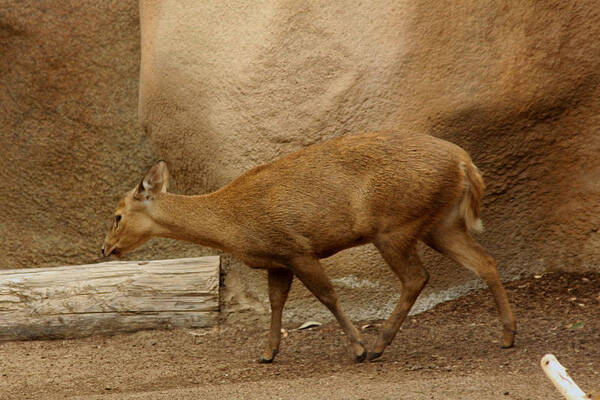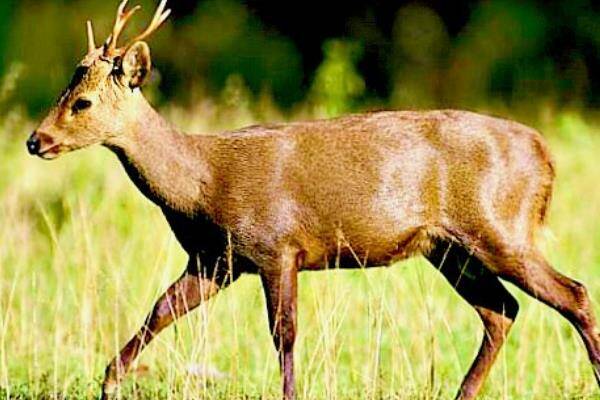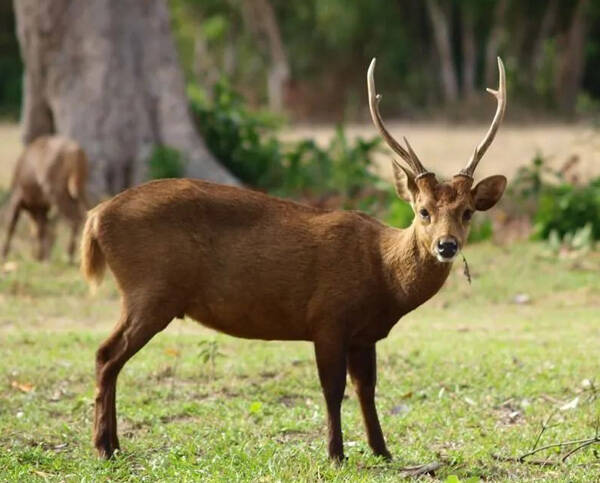Axis calamianensis
IUCN
LCBasic Information
Scientific classification
- name:Axis calamianensis
- Scientific Name:Axis calamianensis,Kashima spotted deer, Kashima hog deer
- Outline:Ungulata
- Family:Artiodactyls Cervidae Cervus
Vital signs
- length:100-115cm
- Weight:35-50kg
- lifetime:12-20years
Feature
The lips are white with dark stripes on the sides
Distribution and Habitat
The Karami Hog Deer is endemic to the Philippines and is restricted to the Calamian Islands in the Palawan Fauna Zone. The species occurs on three of the four larger islands of the Calamian Islands, namely Busuanga, Calauit, and Culion, but is absent from Coron. The species has also been reported on at least nine other smaller islands, including three islands where a small number of individuals were released from Calauit in the late 1980s. The Karami Hog Deer was subsequently reported to be extinct on at least seven (78%) of these islands (Bakabak, Kapali, Panlaitan, Garok, Apo, Alawa, and Dicabaito), and survives only on two of them, namely Marie and Dimarquet. The Karami Hog Deer is unknown from anywhere else in the region, including mainland Palawan, and in the larger intermediate areas of Linacapan Island.
The Karami Hog Deer occurs in grasslands, open woodlands, and secondary forests.
Appearance
The Karami Hog Deer is 100-115 cm long, 60-65 cm tall, with a 15 cm tail and weighs 35-50 kg (23-29 kg for females and 32-40 kg for males). The Karami Hog Deer is a stocky animal with short legs and slightly raised hindquarters. The overall body color is a uniform golden brown, lighter in the lower body. The legs are dark brown (some are almost black) with a dark stripe on the back extending from the shoulder to the base of the tail. The lips are white with dark stripes on the edges. There is a small light-colored bib on the upper part of the throat. The ears are slightly rounded, with the inner surface mainly white.
Only males have antlers, which are three-pronged and grow from a protruding base on the forehead. The average antler length is 23.5 cm, and it has been reported to be up to 39 cm long. Unlike other Asian deer, the Karami Hog Deer is not spotted at birth.
Details
The Calamian Hog Deer (Axis calamianensis) is one of three species of deer native to the Philippines, the other two being the Philippine Brown Deer (Cervus mariannus, Rusa marianna) and the Philippine Water Deer (Cervus alfredi, Rusa alfredi). The word "豚" means piglet, and also refers to pigs in general. The Calamian Hog Deer is called the "pig deer" because when it flees danger, it lowers its head and rushes through the bushes like a pig, rather than jumping over obstacles like other deer.

The Karami Hog Deer rests for most of the day and is active only at sunrise and dusk, emerging from the bushes to forage for food. During periods of extreme heat, activity patterns may become more nocturnal. These deer can jump up to a height of 1.5 meters, but tend to dive under obstacles or into the bushes to escape. The Karami Hog Deer are solitary, sometimes forming small groups if left undisturbed. The species can grow in groups of up to 27 individuals, but is usually 7-14, and much smaller groups have been reported in heavily hunted areas.
Like other deer, the Karami Hog Deer is a ruminant, meaning it has four stomach chambers. Its vocalization is a soft, high-pitched nasal sound. Its diet consists of shoots, twigs, and leaves. It has few natural predators other than birds of prey, pythons, and humans.

The gestation period of the Karami hog deer is about 180 days, and usually one calf is born, rarely twins. The age of sexual maturity is 8-12 months, and the life span is 12-20 years. In captivity, it can live up to 18 years. Breeding occurs throughout the year, and June (the beginning of the rainy season) is reported to be the peak of calving. Cubs are spotless and weigh an average of 1.27 kg at birth (average male: 1.625 kg; female: 1.03 kg). Cubs are kept in hiding spots until they are mobile and can keep up with their mother. Cubs begin to nibble vegetation at around 1 month of age. Antler development in males begins at 8-9 months. Antlers are shed and regrow in a 9-10 month cycle, so males can be found in various stages of antler development throughout the year.
The Karami Hog Deer is listed as an endangered species because its range is less than 5,000 square kilometers; the species is experiencing a sustained decline due to hunting pressure and the expansion of human settlement and agriculture in its very limited range.

The threat to the Kalami Hog Deer is coupled with an apparent lack of effective and sustained enforcement of strong local conservation legislation. Hunting was particularly severe in the mid-1970s, but hunting appears to have declined in most areas during the 1980s and 1990s, with the exception of Kalauit Island, where hunting pressure increased dramatically after the island was resettled by former residents under the auspices of Balik. The species is hunted mostly for recreational purposes and to provide venison to local markets, and the skin is also used for drums and antlers for decoration. Pressure on the habitat of the Karami Hog Deer increased due to the impact of Typhoon Haiyan, the resettlement of affected people, and the establishment of outsiders in Busuanga (which also increased hunting pressure).
Currently, the Karami Hog Deer is considered extinct on the main island of Palawan. Habitat loss due to sea level rise and conversion of grasslands and open woodlands to closed forests are suspected to be the main reasons for the extinction of the species in Palawan. Due to human activities, many semi-open habitats now exist again within the former range of Palawan. Therefore, reintroduction of the Karami Hog Deer to the main island of Palawan is a measure to reduce the risk of extinction of the Karami Hog Deer population in the Calamian Islands.
Protect wild animals and eliminate game.
Maintaining ecological balance is everyone's responsibility!








